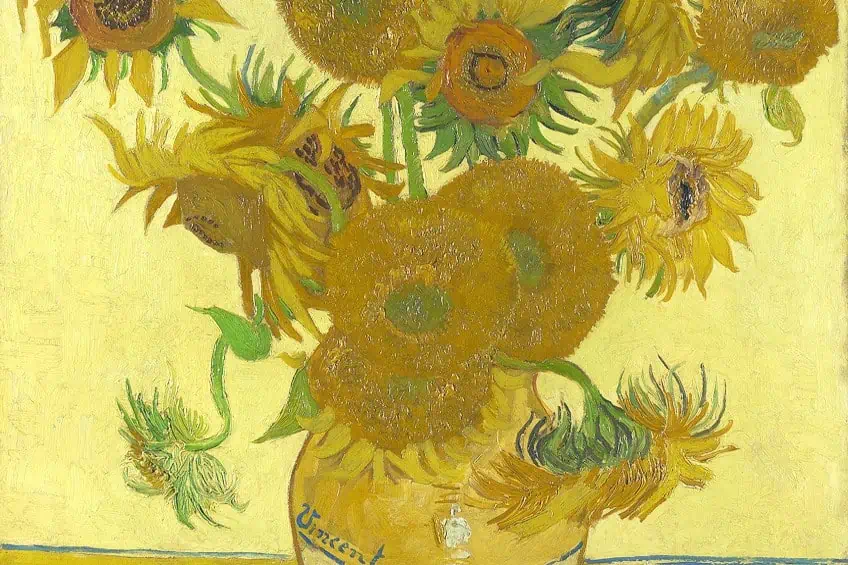“Sunflowers” by Vincent van Gogh – The Dutch Blooms of Brilliance
Imagine a sunflower field – this would have been the ideal spot for an artist like Vincent van Gogh. He is often quoted as saying that “the sunflower is mine”, and that is exactly what he did: he made it his trademark, his signature motif, so to say. This flower has certainly become one of Van Gogh’s most emblematic artistic symbols, and it held a variety of meanings that this article will explore further. Read more below as this article explores his collection of sunflower paintings that were painted from 1887 to 1889.
Artist Abstract: Who Was Vincent van Gogh?
Vincent van Gogh was born on March 30, 1853, and died on July 29, 1890. He was born in North Brabant in the Netherlands. He was one of the leading Post-Impressionist painters and is loved by millions to this day. He was known for his brilliant utilization of colors and expressive brushstrokes and only started his painting career when he was 27 years old.
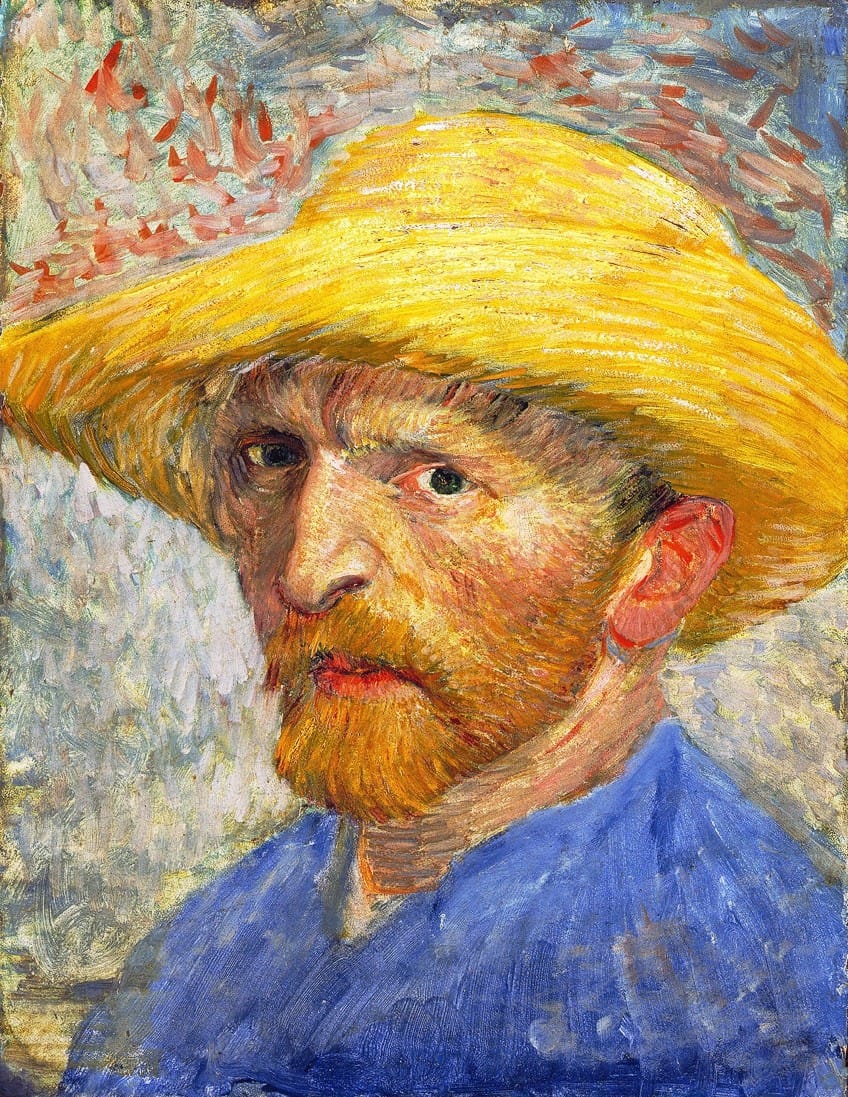
His correspondence with his brother, Theo van Gogh, became part of his artistic oeuvre, and his brother supported him financially. Some of Vincent van Gogh’s famous artworks include The Potato Eaters (1885), The Starry Night (1889), and Almond Blossoms (1890).
Sunflowers (1888) by Vincent van Gogh in Context
| Artist | Vincent van Gogh (1853 – 1890) |
| Date Painted | 1888 |
| Medium | Oil on canvas |
| Genre | Still life |
| Period/Movement | Post-Impressionism |
| Dimensions (Centimeters) | 92.1 x 73 |
| Series/Versions | Part of a series of Sunflowers paintings |
| Where Is It Housed? | National Gallery, London, England |
| What It Is Worth | Bought by the National Gallery in 1924 with financial assistance from the Courtauld Fund. The exact price is uncertain. |
The Vincent van Gogh flower paintings consist of a series of painted still lifes of sunflowers. In the article below you will read more about when they were painted and how many versions Van Gogh created. A formal analysis will discuss one example from the series, titled Sunflowers (1888), held at the National Gallery in London, England, which will highlight Van Gogh’s artistic techniques.
Contextual Analysis: A Brief Socio-Historical Overview
Vincent van Gogh reportedly painted 11 sunflower paintings, seven during his time in Arles and four when he was in Paris. There are several reasons for why he painted them, which tie in with the events of his life. Let us take a closer look at where Van Gogh was when he started painting them and how they progressed. From 1886 to 1888, Vincent van Gogh lived in Paris with his brother Theo van Gogh.
He moved there from Antwerp in Belgium where he attended the Royal Academy of Fine Arts but had a conflict with one of the instructors and eventually decided to leave, meeting up with his brother in Paris, where they lived in Montmartre.
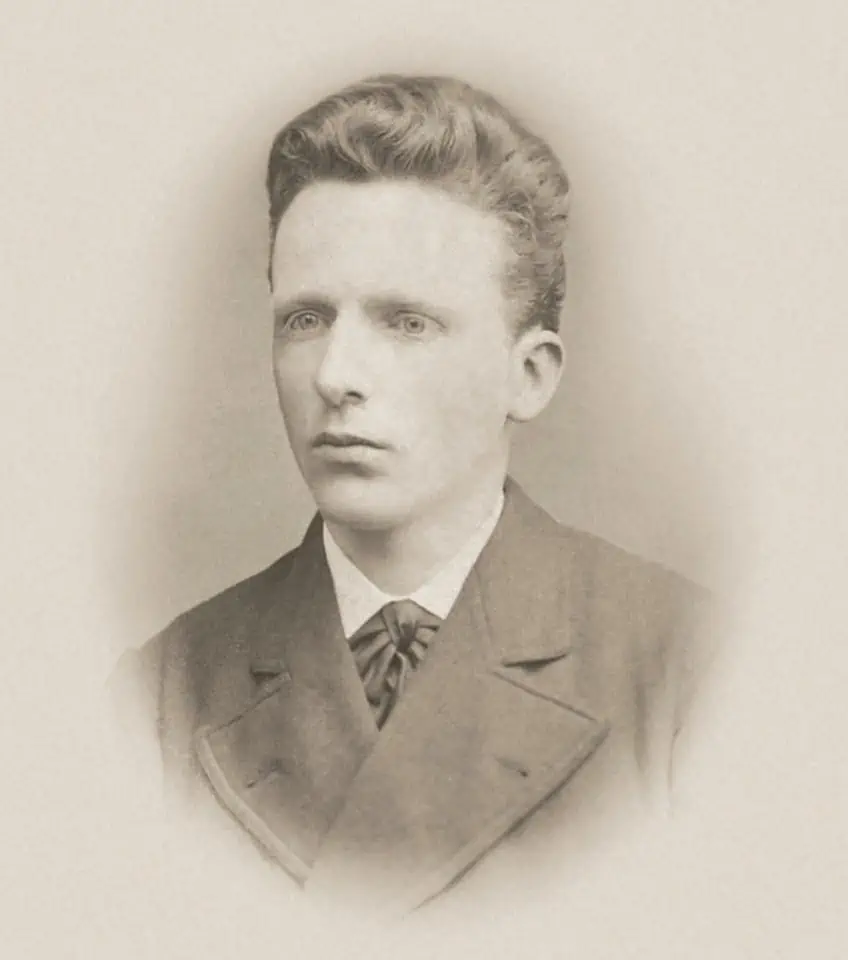
Vincent van Gogh also studied at the studio of French artist, Ferdinand Cormon, where he took drawing lessons. However, Van Gogh’s artistic development reached new heights during his stay in Paris, and he was also involved in learning about the Impressionists and their artistic styles.
Sunflowers in Paris
It was during Vincent van Gogh’s time in Paris that he created numerous still life paintings, including of various floral arrangements, including sunflowers, which became the main subject matter for four of his paintings during 1887. These are, namely, Two Cut Sunflowers (1887), which is housed at the Van Gogh Museum in Amsterdam, the Netherlands, Two Cut Sunflowers (1887) at the Metropolitan Museum of Art in New York City, Two Cut Sunflowers (1887) at the Museum of Fine Arts Bern in Switzerland, and Four Sunflowers Gone to Seed (1887) at the Kröller-Müller Museum in Otterlo, the Netherlands.

Sunflowers in Arles
Vincent van Gogh also painted several sunflowers still lifes when he lived in Arles, where he moved to in February 1888. He moved to Arles to escape the city life of Paris and find warmer weather. It was here where he also lived in the famous Yellow House, which he wanted to convert into a communal space for artists, including his friend, and beloved artist to this day, Paul Gauguin.
Van Gogh reportedly also prepared the room for his new house guest and decorated it with his sunflower paintings.
Paul Gauguin lived with Vincent van Gogh from October 1888 and left in December 1888 due to conflicts between the two artists, which led to Van Gogh cutting off part of his own ear. However, during the two months, the artists created numerous paintings, from portraits to still lifes. Gauguin also painted a portrait of Van Gogh busy painting sunflowers in the oil on canvas Vincent van Gogh Painting Sunflowers (1888), which depicts the artist in the process of painting a vase of sunflowers to the left.

However, the reality of this portrait has been mentioned and Gauguin portrayed a fictional surrounding, including that Van Gogh did not paint sunflowers at that time of the year, which was reportedly December and out of season for the sunflowers. The other seven versions of sunflower paintings that Van Gogh painted during Arles were different in composition compared to the Paris Sunflowers. The Arles versions were depicted in vases and the Paris versions were cut and set on a surface.
The Arles Sunflowers are namely, Three Sunflowers in a Vase (1888), painted in August, and depicts three sunflowers in a green and white vase set against a turquoise background, which is part of a private collection.
The second version is Still Life: Vase with Five Sunflowers (1888), also painted in August. This is depicted against a dark blue background and there are five sunflowers. Three appear to be in the vase and two are wilted, of which one has no leaves, and lying on the table. This version was reportedly destroyed in a fire during World War II when there was an air raid. It was initially part of a private collection in Ashiya, Japan.
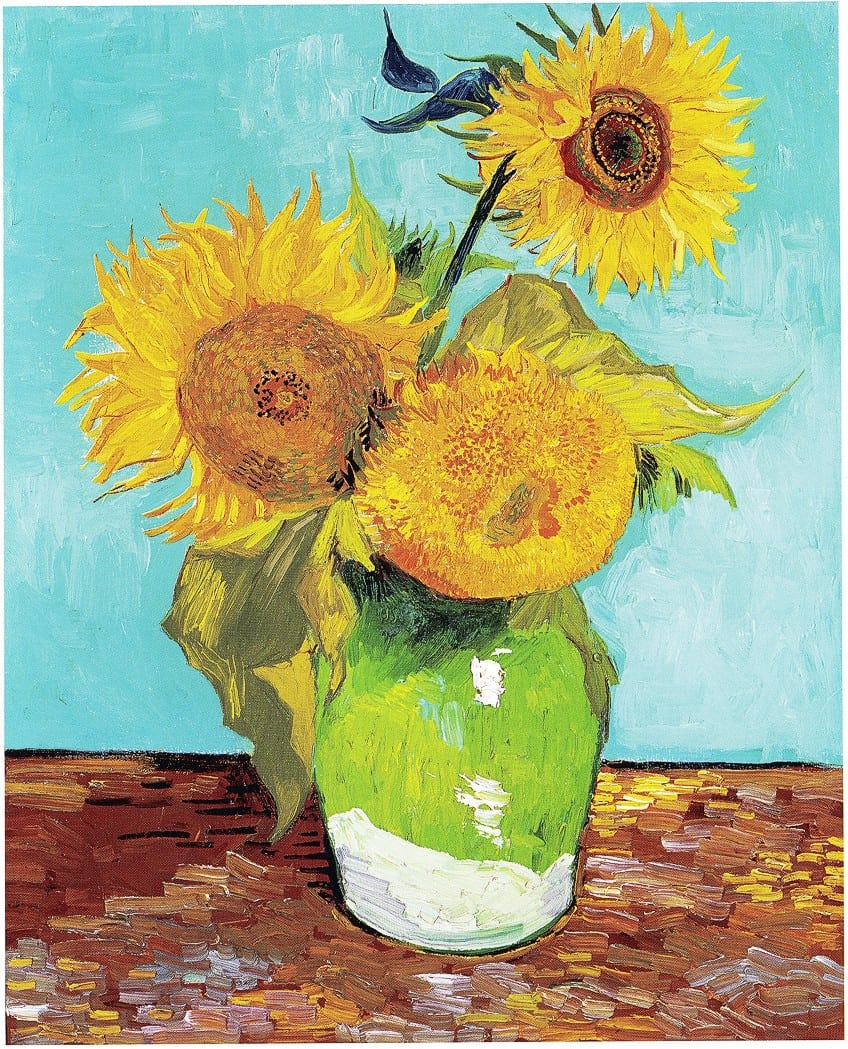
The third version, Sunflowers (1888), also painted in August, depicts 14 (although some sources state 12) sunflowers in a vase against a turquoise background. It is held at the Neue Pinakothek in Munich, Germany. The fourth version, Sunflowers (1888), which was also painted in August, depicts 15 sunflowers in a vase set against a yellow background. Its location is the National Gallery in London.
The third and fourth versions were also signed by Van Gogh and were reportedly the more significant iterations of sunflower paintings for the artist and he also utilized these for the room at the Yellow House where Gauguin stayed.
The fifth version, Sunflowers (1888), which was painted between November and December, is housed at the SOMPO Museum of Art in Tokyo, Japan. It is a replica that Van Gogh made, reportedly of his fourth version that is at the National Gallery. Although the fifth version is a replica, there are stylistic differences, notably the colors and the brushstrokes, the latter of which appear more expressive and vigorously applied with thicker impasto paint. This is evident on the vase and table surface, which is patterned with Van Gogh’s horizontal, short, and somewhat choppy brushstrokes.
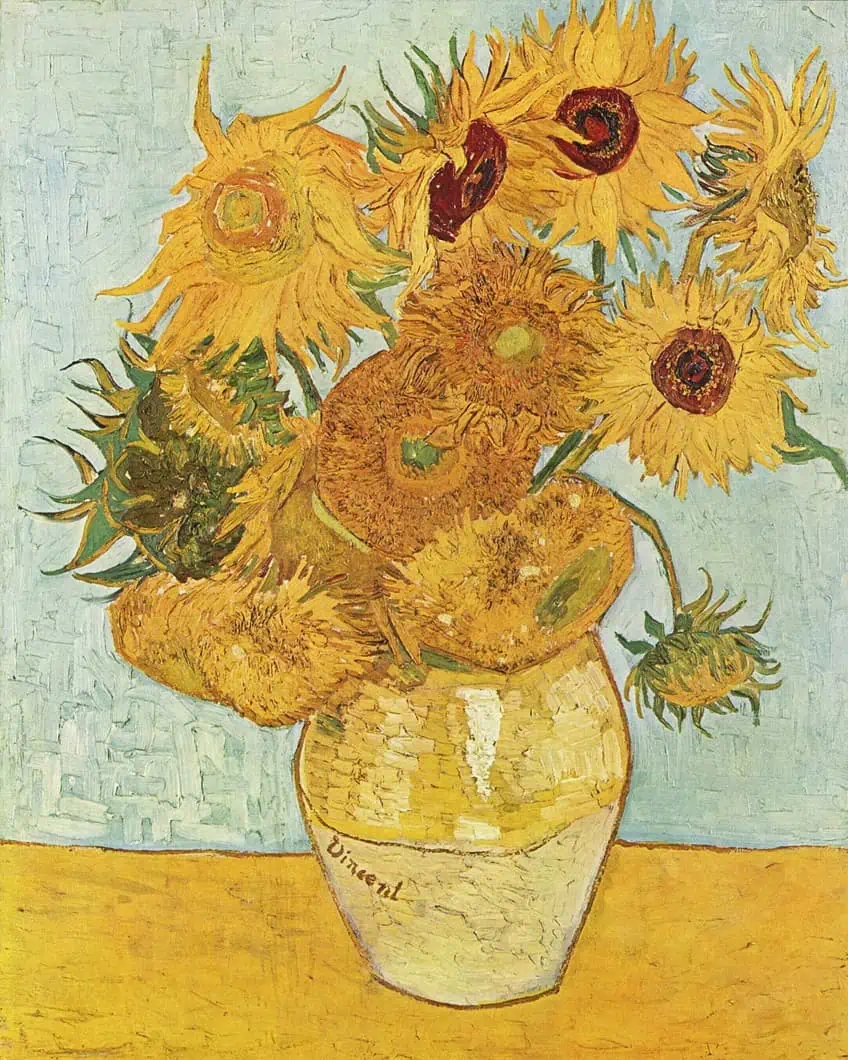
The sixth version, Sunflowers (1889), was painted in January and is housed at the Philadelphia Museum of Art in Philadelphia, Pennsylvania, United States. This is a copy of the third version housed at the Neue Pinakothek in Munich. The seventh version, Sunflowers (1889), was also painted in January and is housed at the Van Gogh Museum in Amsterdam. It is a replica of the fourth version at the National Gallery. Both sporting a yellow background.
Still Life, Sunflowers, and Symbolism
Van Gogh was reportedly also influenced by the light and color-filled compositions he saw in the Impressionist paintings during his stay in Paris. He incorporated and experimented with his own color combinations in numerous other still-life paintings.
An example of some of Vincent van Gogh’s earlier still life paintings include his Vase with Gladioli and Chinese Asters (1886), which depicts his expressive brushwork and how he placed the red and green, which are complementary colors, alongside each other. A pop of red meets the eye to the right.
The entire series of Vincent van Gogh Sunflowers paintings are enriching to look at with a dominant yellow emanating through, but there is more to these Van Gogh oil painting series of sunflowers than meets the eye, and the color yellow is the tell-tale sign. One of the common interpretations of what these Sunflowers symbolized to Vincent van Gogh is related to happiness and the color yellow reportedly represented this emotion to him, which he depicted through the ranges of yellow applied to his sunflower still lives.

Another meaning has been tied to what Van Gogh said himself, that it may mean “gratitude”. This was noted when the artist reportedly wanted to place two Sunflowers paintings, the versions held in London and Munich, alongside the painting titled La Berceuse (Portrait of Madame Roulin) (1888 – 1889), which is held at the Kröller-Müller Museum in Otterlo, Netherlands. According to Van Gogh’s letter from January 28, 1889, to his brother Theo van Gogh, the artist explained that he wanted the two Sunflowers paintings to act as “candelabras” or “torches” beside the portrait painting La Berceuse.
These two above-mentioned Sunflowers paintings were exhibited by Vincent van Gogh at the Les XX exhibition in Brussels Belgium in 1890.
Les XX, otherwise Les Vingt, was an annual event started by one of its primary founders, Octave Maus. Through invitation-only, artists were asked to exhibit their works, of which Van Gogh was one of them. Other meanings for Sunflowers by Van Gogh have pointed to them symbolizing friendship, notably, that of Vincent van Gogh’s friendship with Paul Gauguin. As previously mentioned, Van Gogh set up the Yellow House for his friend’s arrival in Arles and decorated the room where Gauguin would stay with sunflower paintings.
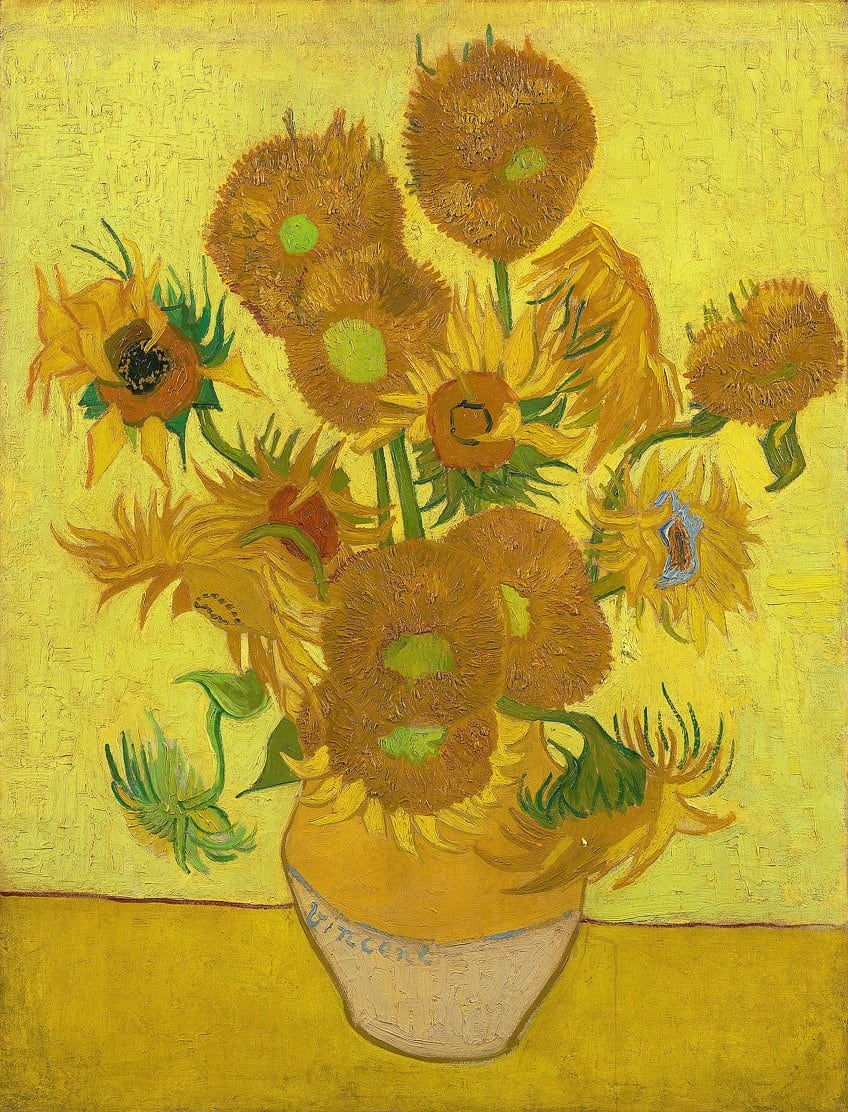
Furthermore, sunflowers have also been connected to symbolizing nature and Vincent van Gogh depicted these in various life cycles, from bud to blossom. Van Gogh’s artworks are a testament to his love of nature and how he always sought to depict a new and unique perspective of a natural setting or object, and the sunflowers are a large part of this.
Formal Analysis: A Brief Compositional Overview
In the formal analysis below, you will read more about the painting titled Sunflowers from 1888, which is housed at the National Gallery in London, England. A visual description of the subject matter will illustrate this Vincent van Gogh oil painting, a seemingly sunflower field of yellows. This will be followed by a description of how each of the main art elements, namely color, value, texture, line, shape, form, and space, are utilized, which will describe how the artwork is composed.
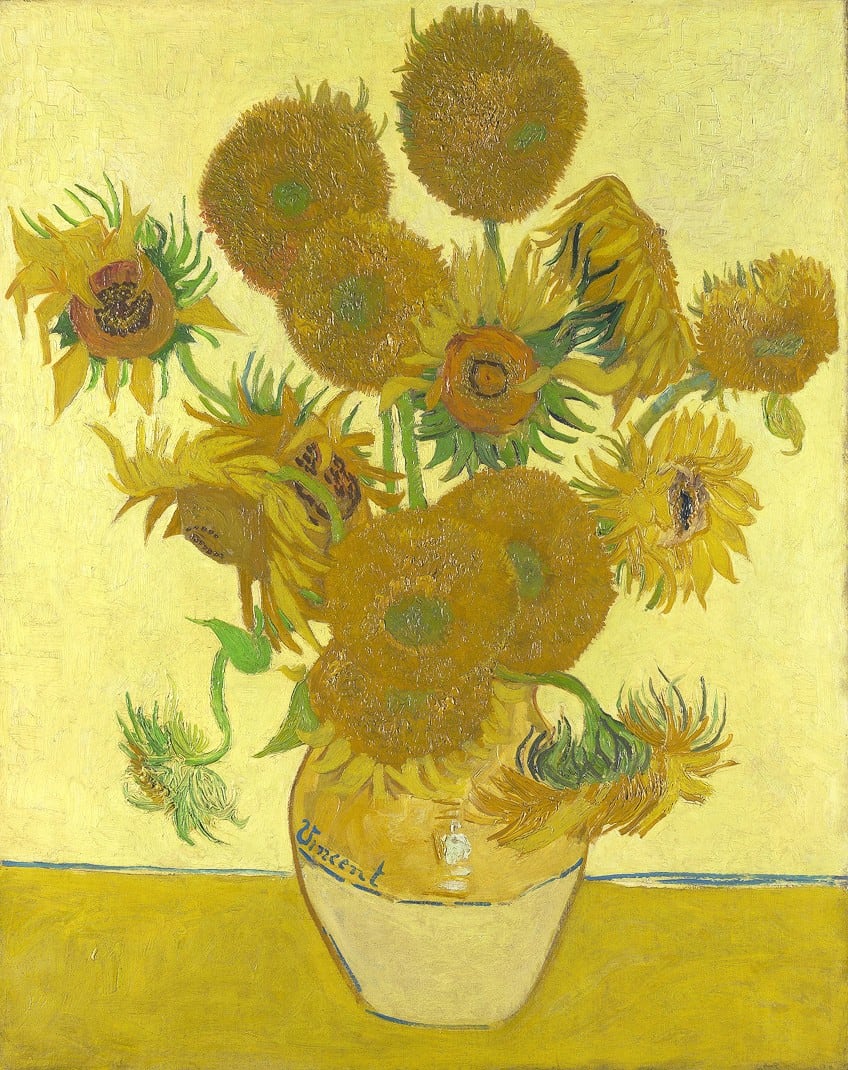
Subject Matter: Visual Description
Sunflowers by Van Gogh depicts 15 sunflowers in a beige/white and yellow colored vase that is centrally placed in the composition. The vase is halved by a roughly drawn blue convex-shaped line. The vase is on a mustard-yellow colored surface, possibly a tabletop, which composes approximately the lower third portion of the composition.
A horizontal and slightly diagonal blue line is roughly traced along the line created by the table. This separates the table between the wall, which is a lighter pastel-colored yellow and composes approximately the upper two-thirds of the composition.

The flowers fill the upper portion of the composition, and there are 15 all in different stages of bloom, some are buds, wilted, and some are blossomed. Van Gogh’s signature is written in blue as “Vincent” along the line on the middle half of the vase. Interestingly, Van Gogh did not leave his signature on all his Sunflowers paintings, and it is only visible on several.
Color and Value
Sunflowers by Van Gogh depicts a vibrant color harmony through the utilization of yellows, from tints to shades. There are also oranges, blues, greens, and reds, however, the yellows are the dominant colors utilized in the composition. Yellow is also one of the primary colors, which Van Gogh placed alongside secondary colors like green.

Another primary color, blue, is placed as the dividing line between the table and the background of the composition, including the line in the middle of the vase. The lower third portion of this Van Gogh artwork is a mustard yellow color, which contrasts with the lighter yellow of the background (or wall), and, additionally, the flowers and vases all blend in with these. Van Gogh also depicted a light source on the front of the vase, which is evident through the white patch of paint, or highlights, that suggest the light’s reflection.
Texture
This version of the Vincent van Gogh Sunflowers painting depicts not only tactile texture from the artist’s thick, impasto, brushstrokes but also the implied texture of the subject matter. Van Gogh’s expressive utilization of brushstrokes is long, short, thick, thin, and curved brushstrokes in various areas around the composition. Examples include the sunflowers’ leaves and petals, which appear in thin and thick brushstrokes, and the sunflower buds appear in more concentrated short, and choppy brushstrokes.
The tabletop and background appear somewhat smoother in texture, however, Van Gogh’s brushstrokes are still evident, and applied in various directions, as if he applied these in a rush.

The implied texture is evident in the reflection of light on the vase, which provides it with the impression of being a glazed, and possibly a ceramic vase. Furthermore, the green stems are bent, which gives the impression of softness and bendability. The sunflowers themselves appear soft due to their drooped nature, and the choppy brushstrokes of the buds provide the impression of a more bristly and hairy texture.
Line
There are a variety of lines in this Vincent van Gogh Sunflowers version. For example, notice the uneven outlines around the vase including the blue horizontal line that demarcates the background and the table. Irregular lines delineate the subject matter, notably the sunflowers and their stems, for example, there are short, long, diagonal, curved, round, and straight types of lines, which all create a sense of naturalism and a dynamism of the subject matter.
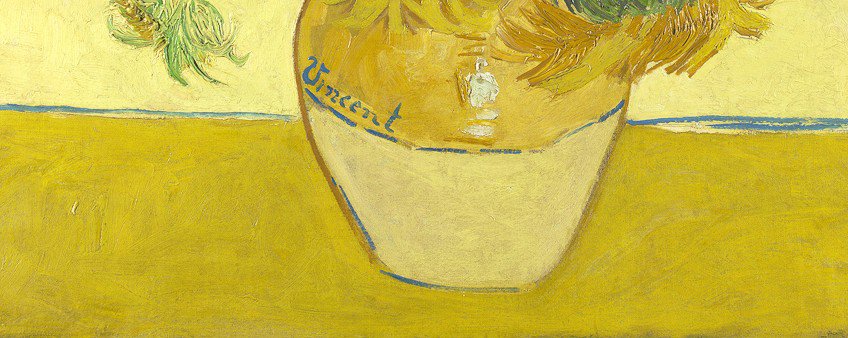
Shape and Form
There are a variety of shapes and forms in this Vincent van Gogh Sunflowers painting, which range from organic to geometric. The forms of the sunflowers are organic and irregular because they resemble the natural forms that would be found in nature.
Geometric shapes include circles that delineate the buds of the sunflowers and the semi-triangular shapes of their leaves. The vase also appears geometric in its bulbous shape.
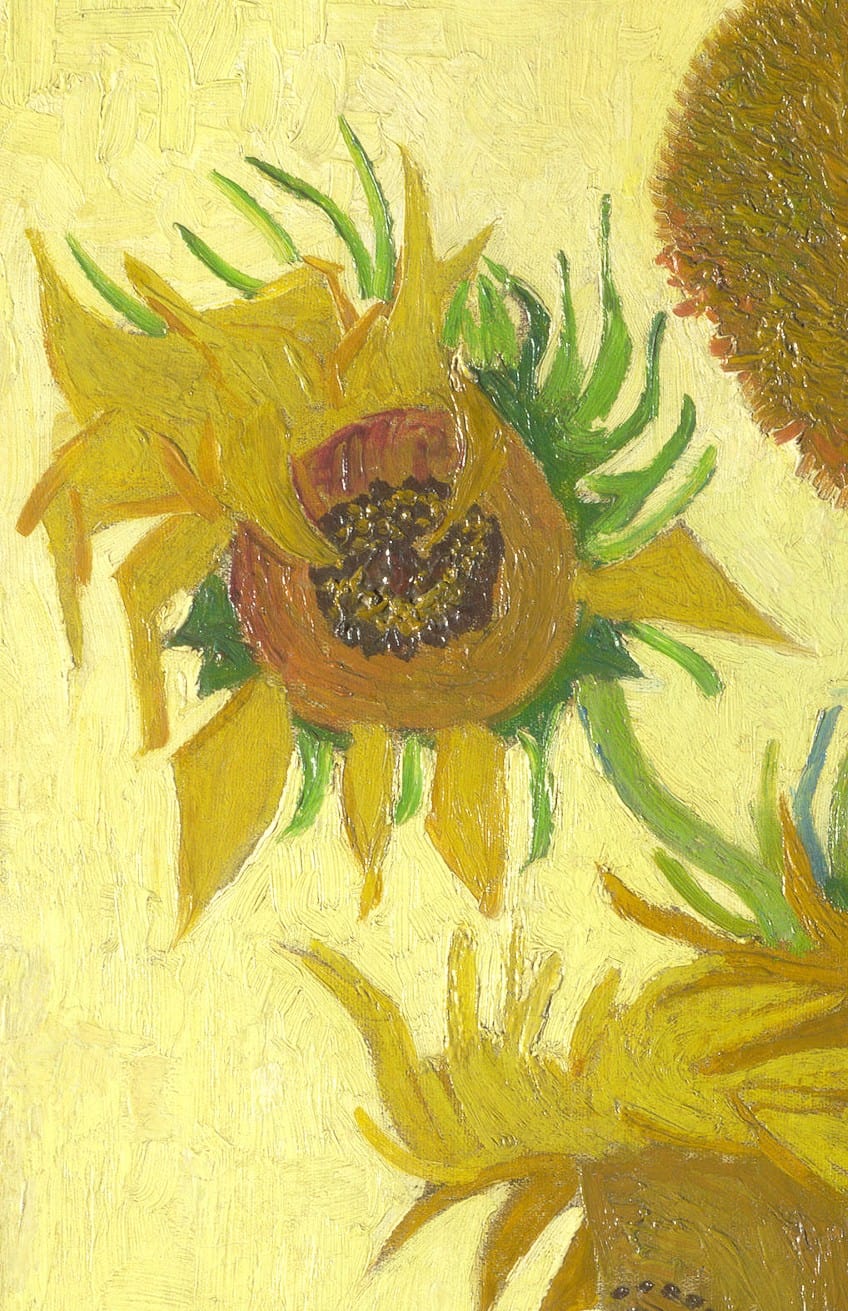
The blue horizon line also creates a geometric effect, dividing the vertical orientation of the composition into two halves making it appear block-like. The naturalistic forms of the sunflowers create a contrasting effect with the more geometric background, which is ultimately created by the blue horizon line.
Space
Vincent van Gogh filled up the compositional space with his bouquet of sunflowers in the vase. Most of the composition is filled with sunflowers positioned in their dazzling directions leaving the lower third empty with only the vase on the table, however, there is a balance of the subject matter because the sunflowers are centrally placed and create a weighted effect on either side of the composition.

The Beauty of a Sunflower
This article explored and discussed the significance of the Vincent van Gogh artwork collection titled Sunflowers. The artist painted 11 of these flower paintings and each was unique and illustrated the artist’s love and passion for not only any flower but the beauty of sunflowers.
Furthermore, the article also discussed the Sunflowers version held at the National Gallery in London.
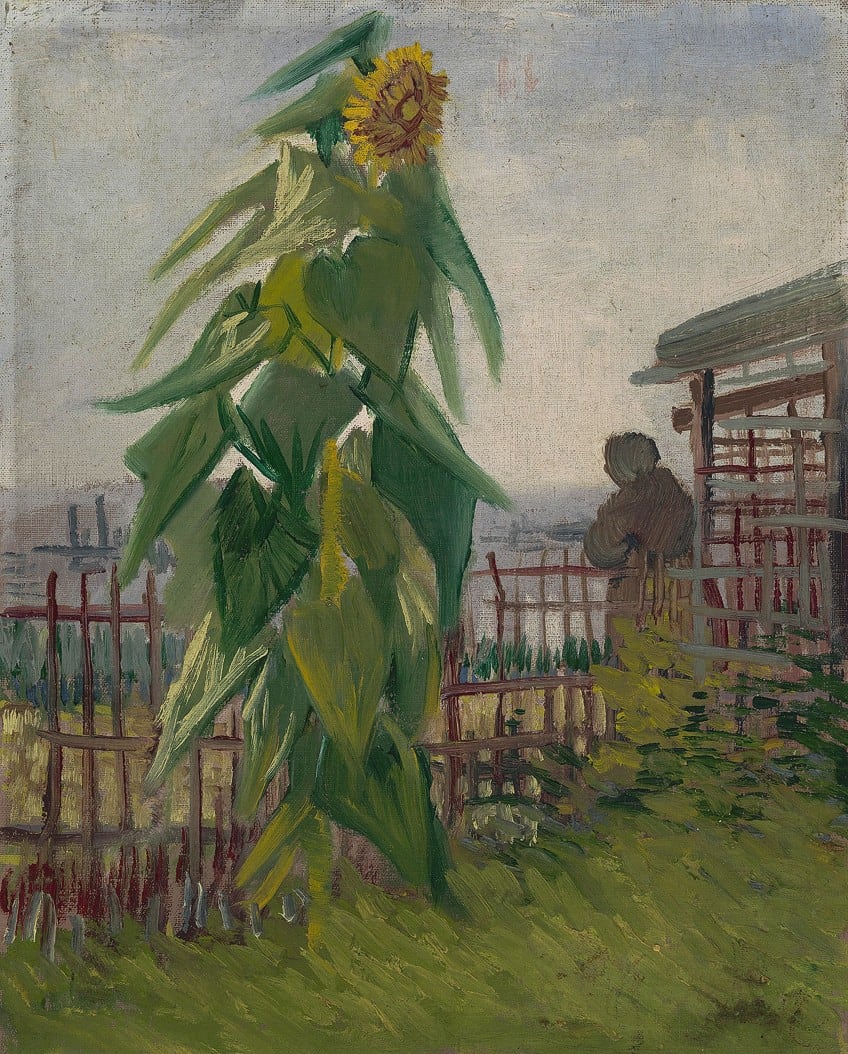
This was also the version that received a dose of tomato soup from protesting activists in 2022, however, it survived the onslaught due to its protective covering. Throughout Vincent van Gogh’s life, he had mental breakdowns and health problems, but one constant in his life was his art, his self-expression, which tied him to something deeper and more wholesome than his circumstances.
Sunflowers became one of the most important series of artworks of Vincent van Gogh’s flower paintings, but also in his overall artistic oeuvre. These flowers have often been described as “synonymous” with Vincent van Gogh, and undoubtedly occupied a special place in the artist’s heart and mind. It left a cheerfulness where there may have been darkness for him.
Frequently Asked Questions
How Many of the Sunflower Paintings by Vincent van Gogh Are There?
There are reportedly 11 of the Van Gogh flower paintings depicting sunflowers, which the artist painted between 1887 and 1889. These are still-life paintings depicting the sunflowers from different angles; some are in vases, and some are close-ups.
Why Did Vincent van Gogh Paint Sunflowers?
While there are several reasons why Van Gogh painted sunflowers, some of the common reasons include when he painted them for Paul Gauguin’s visit to the Yellow House in Arles in 1888. Other reasons include Vincent van Gogh’s experimentation with color combinations.
Where Are Vincent van Gogh’s Sunflower Paintings?
Vincent van Gogh’s Sunflowers paintings are held in different locations around the world, and he reportedly painted seven while in Arles and four in Paris. The locations include the Van Gogh Museum in Amsterdam, the Netherlands, the Metropolitan Museum of Art in New York City, the United States, the Museum of Fine Arts in Bern, Switzerland, the Kröller-Müller Museum in Otterlo, the Netherlands, the Neue Pinakothek in Munich, Germany, SOMPO Museum of Art in Tokyo, Japan, Philadelphia Museum of Art in Philadelphia, United States, and the National Gallery in London, England, and private collections.
What Are the Sunflowers by Vincent van Gogh Worth?
The collection of Sunflowers paintings by Vincent van Gogh are dispersed in various art collections, and some have been on loan from the artist’s estate while others have been sold. Not all the prices are clear, but reportedly a Japanese businessman, Yasuo Goto, bought the Still Life: Vase with Fifteen Flowers for just over $39 on March 30, 1987.
What Colors Did Vincent van Gogh Use In Sunflowers?
Vincent van Gogh utilized several types of yellow paints for his Sunflowers paintings. An example, according to studies, suggests that he utilized chrome yellow.
Did Paul Gauguin Paint Sunflowers?
When Paul Gauguin stayed with Vincent van Gogh in the Yellow House, he painted a portrait of Van Gogh whilst painting Sunflowers, although it was reportedly not the sunflower season. The artwork in question is titled Vincent van Gogh Painting Sunflowers (1888). It is a representation of Van Gogh by his easel, busy painting his well-known sunflower still life.
Jordan Anthony is a Cape Town-based film photographer, curator, and arts writer. She holds a Bachelor of Art in Fine Arts from the University of the Witwatersrand, Johannesburg, where she explored themes like healing, identity, dreams, and intuitive creation in her Contemporary art practice. Jordan has collaborated with various local art institutions, including the KZNSA Gallery in Durban, the Turbine Art Fair, and the Wits Art Museum. Her photography focuses on abstract color manipulations, portraiture, candid shots, and urban landscapes. She’s intrigued by philosophy, memory, and esotericism, drawing inspiration from Surrealism, Fluxus, and ancient civilizations, as well as childhood influences and found objects. Jordan is working for artfilemagazine since 2022 and writes blog posts about art history and photography.
Learn more about Jordan Anthony and about us.
Cite this Article
Jordan, Anthony, ““Sunflowers” by Vincent van Gogh – The Dutch Blooms of Brilliance.” artfilemagazine – Your Online Art Source. December 18, 2023. URL: https://artfilemagazine.com/sunflowers-by-vincent-van-gogh/
Anthony, J. (2023, 18 December). “Sunflowers” by Vincent van Gogh – The Dutch Blooms of Brilliance. artfilemagazine – Your Online Art Source. https://artfilemagazine.com/sunflowers-by-vincent-van-gogh/
Anthony, Jordan. ““Sunflowers” by Vincent van Gogh – The Dutch Blooms of Brilliance.” artfilemagazine – Your Online Art Source, December 18, 2023. https://artfilemagazine.com/sunflowers-by-vincent-van-gogh/.


